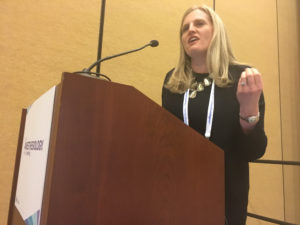The use of monitored anesthesia care (MAC) has increased exponentially over the past decade, but questions remain about its safety compared with a general anesthetic (GA). The debate in Sunday’s session “MAC Is More Dangerous Than GA — Reality or Myth?” illustrated the challenges in making a true comparison between the two.
Representing the “reality” side of the debate, Kate Hagan, M.D., Assistant Professor, Department of Anesthesiology and Perioperative Medicine at the University of Texas MD Anderson Cancer Center, noted the difficulty in defining MAC. According to the most recent definition, an anesthetic is considered MAC unless the patient was unconscious for more than 50 percent of the procedure. However, it’s difficult to determine the depth of anesthesia during a procedure. Dr. Hagan referenced a study in which bispectral (BIS) monitoring showed that moderate sedation was only transient during the first five to 10 minutes of a procedure, with the sedation levels increasing and deep sedation and general anesthesia being measured in all patients.

Kate Hagan, M.D., compares the challenges of MAC and GA.
Discussing data from the ASA Closed Claims Project Database, Dr. Hagan said that MAC accounts for a higher proportion of deaths compared with regional and general anesthesia. Respiratory depression, due to oversedation during MAC, accounted for 30 percent of remote-location claims. MAC is used primarily for endoscopic procedures, which account for about one-third of MAC cases. Those figures continue to rise.
Studies based on a closed claims database have limitations, including the lack of a denominator, a lag time from data availability to publication and confusing terminology, she said. Several terms are used to describe various methods of administering anesthetics, and interpretations vary.
Perspective also matters. Survival may be better for MAC. However, available data do not confirm clinical relevance.
Most patients who receive MAC are healthier and have minimum blood loss during the procedure. “The patient populations are very different. We need to look at individual risk versus population risk and decide what is safest and best for our patient,” Dr. Hagan said.
In presenting the other side of the debate, Basavana Goudra, M.D., FRCA, FCARCSI, Clinical Associate Professor of Anesthesiology and Critical Care Medicine at the Perelman School of Medicine, Hospital of the University of Pennsylvania, agreed with many of Dr. Hagan’s points. He also reviewed data from the ASA Closed Claims Project Database. Dr. Goudra acknowledged that death was significantly more common in claims associated with MAC than in claims associated with GA or RA.
However, he emphasized that MAC is commonly used for endoscopy, and the findings of studies of MAC in the gastroenterology literature differ from the data in the closed claims database. Those studies involve endoscopist-directed administration of anesthetics. According to a meta-analysis conducted by Dr. Goudra and his colleagues, the mean dose of propofol administered by non-anesthesia providers is much lower than that given by anesthesia providers (251.44 mg versus 340.32 mg). This finding reflects deeper sedation when MAC is administered by anesthesiologists. This may account for the differences in outcomes and illustrates the challenge in comparing MAC to GA.
Dr. Goudra observed that more often than not, anesthesia providers give GA in the name of MAC, but without the safeguards built into GA.
Both Dr. Hagan and Dr. Goudra mentioned potential solutions to address the challenges of MAC versus GA. These included using a high-flow nasal cannula, reducing the dose of propofol given and avoiding an opioid combination (unless there is a good reason for it).
Dr. Goudra reminded attendees, “When the patient is scheduled for MAC, provide MAC and not general anesthesia.”
Return to Archive Index